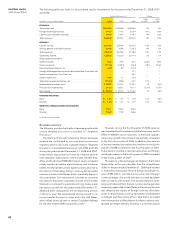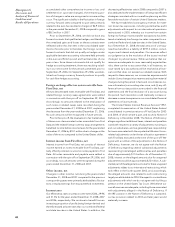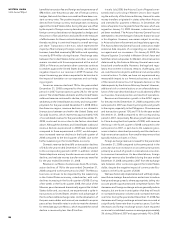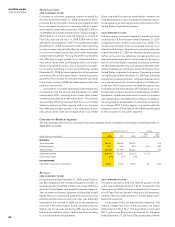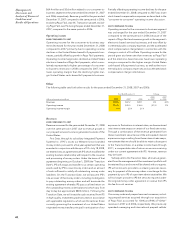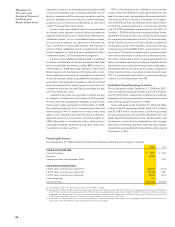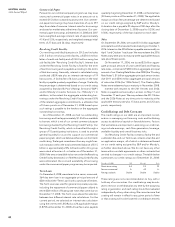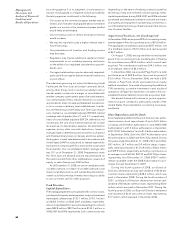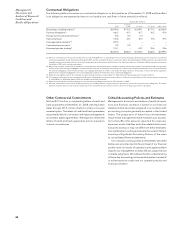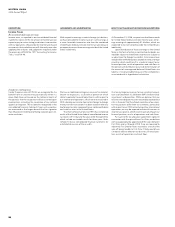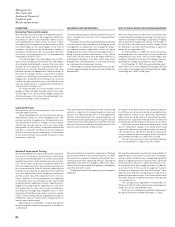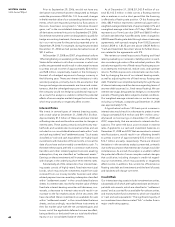Western Union 2008 Annual Report Download - page 32
Download and view the complete annual report
Please find page 32 of the 2008 Western Union annual report below. You can navigate through the pages in the report by either clicking on the pages listed below, or by using the keyword search tool below to find specific information within the annual report.WESTERN UNION
2008 Annual Report
3030
top-up businesses, which were shut down or disposed of
in early 2006. Revenue remained relatively constant for the
year ended December 31, 2007, due to moderate growth
in our money order and prepaid services businesses, offset
by the loss of revenue from our shut-down or disposed
of businesses, which generated revenue for a portion of
2006, while neither business generated revenue in 2007.
Operating Income
2008 COMPARED TO 2007
For the year ended December 31, 2008, the decrease in
operating income was driven by operating income declines
related to our money order business, costs incurred to
develop mobile money transfer services and our prepaid
business within the United States, offset by increased
revenue and related profits from our prepaid services
business outside of the United States.
2007 COMPARED TO 2006
For the year ended December 31, 2007, the increase in
operating income was driven by modest growth from our
prepaid services.
Further financial information relating to each of our
segments’ external revenue, operating profit measures
and total assets is set forth in Note 17 to our consolidated
financial statements.
Capital Resources and Liquidity
Our primary source of liquidity has been cash generated
from our operating activities, derived primarily from net
income, and fluctuations in working capital. Our work-
ing capital is affected by the timing of interest payments
on our outstanding borrowings, timing of income tax
payments, and collections on receivables, among other
items. The majority of our interest payments are due in
the second and fourth quarters which results in a decrease
in the amount of cash provided by operating activities in
those quarters, and a corresponding increase to the first
and third quarters.
Our future cash flows generated from operating activi-
ties could be impacted by a variety of factors, some of
which are out of our control, including changes in eco-
nomic conditions, especially those impacting the migrant
population, and changes in income tax laws or the status
of income tax audits.
A significant portion of our cash flows from operating
activities has been generated from subsidiaries, some
of which are regulated entities. These subsidiaries may
transfer all excess cash to the parent company for gen-
eral corporate use, except for assets subject to legal or
regulatory restrictions. Such assets include those located
in countries outside of the United States containing restric-
tions from being transferred outside of those countries
and cash and investment balances that are maintained by
our regulated subsidiary to secure certain money transfer
obligations initiated in the United States in accordance
with applicable state regulations in the United States.
Significant changes in the regulatory environment
for money transmitters could impact our primary source
of liquidity.
On December 5, 2008, we entered into a senior,
unsecured, 364-day term loan in an aggregate principal
amount of $500 million (the “Term Loan”) with a syndicate
of lenders. The Term Loan was used for general corporate
purposes, including the repayment of commercial paper
utilized to retire $500 million of floating rate notes that
came due on November 17, 2008. As market conditions
allow, we intend to refinance our Term Loan in 2009 with
new financing sources. Based on market conditions at
the time such re-financing occurs, we may not be able to
obtain new financing under similar conditions as histori-
cally reported.
Taking into account our projected share repurchases,
dividends, our pending acquisition, capital expenditures,
and debt service during 2009, we believe our cash flows
generated from operating activities and available financ-
ing sources will provide us with an adequate source of
liquidity to meet the needs of our business.
Cash and Investment Securities
As of December 31, 2008, we have cash and cash equiva-
lents of $1.3 billion. Our foreign entities held $597.9 million
of our cash and cash equivalents at December 31, 2008.
Our ongoing cash management strategies to fund our
business needs could cause United States and foreign
cash balances to fluctuate.
Repatriating foreign funds to the United States would,
in many cases, result in significant tax obligations because
most of these funds have been taxed at relatively low
foreign tax rates compared to our combined federal and
state tax rate in the United States. We expect to use foreign
funds to expand and fund our international operations
and to acquire businesses internationally.
On September 15, 2008, we requested redemption
of our shares in the Reserve International Liquidity Fund,
Ltd. (the “Fund”), a money market fund, totaling $298.1
million. We did not receive any portion of the redemption
payment prior to December 31, 2008, and accordingly,
we have reclassified the total amount due from “Cash and
cash equivalents” to “Other assets” in the consolidated
balance sheet as of December 31, 2008. This surplus cash
was not required or used for daily operations. At the time
the redemption request was made, we were informed by
the Reserve Management Company, the Fund’s invest-
ment advisor (the “Manager”), that our redemption trades
would be honored at a $1.00 per share net asset value.
On January 30, 2009, we received a partial distribution
from the Fund of $193.6 million. We expect to receive
the remaining redemption amount based on written and
verbal representations from the Manager to date and our
current legal position regarding our redemption priority.
We expect to receive the remaining payment based on
the maturities of the underlying investments in the Fund
and the outcome of the litigation process. There is a risk
the redemption process could be delayed and that we
could receive less than the $1.00 per share net asset value,
should a pro-rata distribution occur. Based on net asset
information provided by the Fund, our exposure related
to pro-rata distribution could be $12 million, excluding
settlement costs incurred by the Fund. We believe that,


